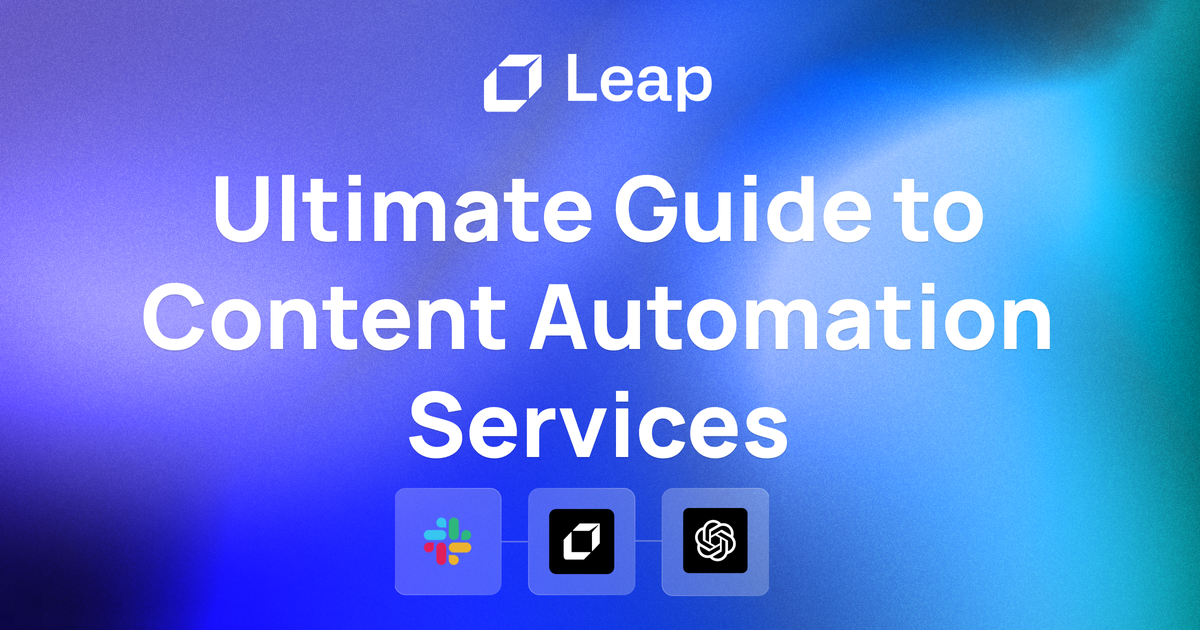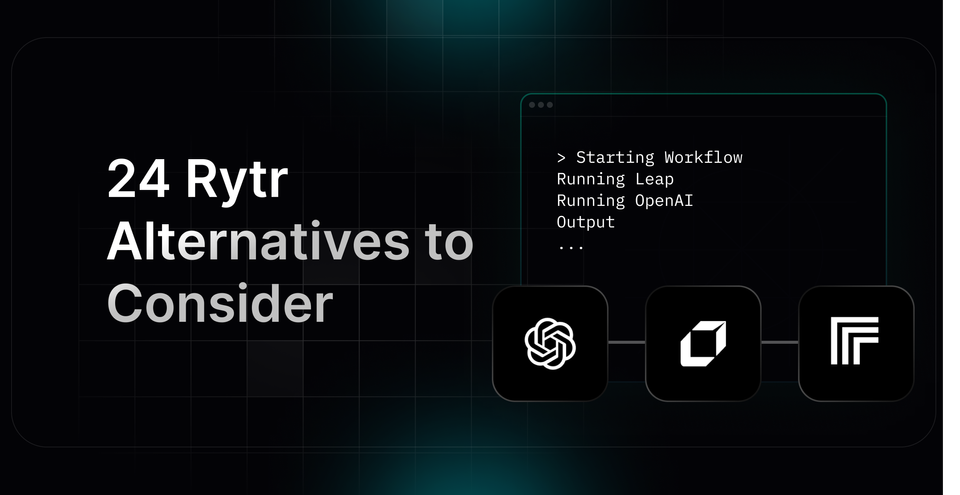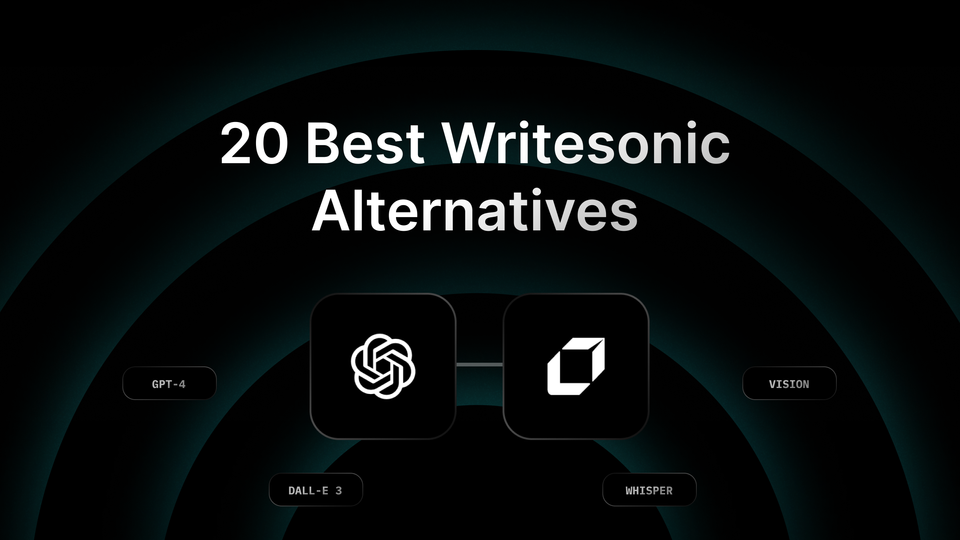Ultimate Guide to Content Automation Services (+ Top 18 Tools to Use)
Simplify your workflow with content automation services. Find out what you need to know about these services and the top tools in this guide.

Content automation services can transform your content production process by streamlining tasks such as content ideation, development, and distribution. These services use artificial intelligence to automate various stages of the content creation process, saving you time and resources. By delegating repetitive content tasks to automation tools, you can focus on high-value activities like strategy development and optimization. Consequently, you not only save time but also enhance the overall quality of your content. Automated content tools also help your team to collaborate more efficiently by aligning content across various channels.

What are AI-Powered Content Automation Services?

Content automation refers to the tools and processes that perform any function in the content lifecycle while requiring minimal human input. These tools are not meant to make humans obsolete. Instead, they expand opportunities for your team’s specialized, creative outputs.
These tools are particularly relevant to content marketing professionals because successful content marketing requires targeted engagement across a wide variety of channels. This means that content must be continuously generated, frequently updated, and consistently effective. Automating these processes saves both time and money while amplifying and replicating the very best content.
Empowering Content Marketing with AI
AI can aid in content ideation, facilitate content creation, its publishing and distribution, and analysis of the content’s performance. It’s all possible now thanks to technologically advanced tools, including content marketing software platforms. AI can boost productivity, make your content plan more efficient, and enable better communication and transparency.
Content marketing is evolving, and to maintain a competitive advantage, you’ll benefit from embracing AI and content automation. At Content Marketing World 2019, Chris Penn of Trust Insights presented on this very topic and here are a few applications that are noteworthy for content marketers.

Related Reading
7 Benefits of AI-Powered Content Automation Services

1. Efficiency and Time Savings
Content automation significantly reduces the time and effort required for manual content creation and management. This allows content creators to allocate their time to higher-value tasks, such as strategy development and creative ideation.
2. Consistency and Quality
Automation helps maintain a consistent tone, style, and messaging across various content platforms, ensuring brand identity is upheld. It also reduces the likelihood of errors, resulting in higher-quality content.
3. Personalization and Improved User Experience
By leveraging AI and data analysis, content automation can create personalized content that is tailored to individual user preferences and behavior, leading to higher engagement and an improved user experience.
4. Scalability and Adaptability
Content automation allows businesses to quickly scale their content production efforts to meet increasing demands or to adapt to changing market trends, without a corresponding increase in resources or cost.
5. Data-Driven Decision Making
AI-driven content automation provides insights into content performance, enabling businesses to make data-informed decisions and adjustments to their content strategy, driving better results and a higher return on investment.
6. Competitive Advantage
Embracing content automation can provide businesses with a competitive edge, as they can create and distribute more relevant and engaging content at a faster pace than their competitors who rely solely on manual processes.
7. Cost savings
Efficiency and cost savings go hand in hand. Content automation means smaller, more specialized teams. It means avoiding sunk costs by only investing in content and campaigns with data-backed projections for success.
Maximizing Efficiency with AI-Powered Workflow Automation
Leap helps you to automate your work with the power of AI. Partnered with Zapier, Vercel, and more, Leap enables you to supercharge your work by allowing you to create custom AI automations. Create sophisticated AI automations with no-code. Connect the tools you love with best-in-class AI text, image, and audio models.
Supercharge your existing tools with seamless AI integrations to OpenAI, Microsoft, and more. From summarizing documents, to voice translation, to AI call transcription, to AI avatar and asset generation, to SEO automation, to even automating the cold email creation and sending process, automate anything with Leap Workflows. The opportunities for automation are endless with Leap workflows.
Try Leap’s AI Workflows tool for free today.
6 Key Features of AI-Powered Content Automation Tools

1. Natural Language Processing (NLP)
AI content generators employ NLP algorithms to understand and process human language. This enables them to generate coherent and contextually-appropriate content that mimics human-like writing.
2. Customization and Personalization
AI content generators let users customize the generated text to match their voice, tone, and style. In this way, the content aligns with the brand's identity and resonates with the target audience.
3. Grammar and Spelling Accuracy
AI content generators come equipped with advanced grammar and spelling-checking capabilities. They can instantly detect and correct errors, ensuring the generated content is error-free and of high quality.
4. Topic Research and Sourcing
AI content generators can assist in topic research by providing relevant information and suggesting sources for further exploration. This feature saves time and effort, allowing writers to quickly gather valuable insights and data.
5. Content Optimization
AI content generators also offer optimization features that help improve SEO performance. They can suggest relevant keywords, optimize meta tags, and provide SEO-friendly content suggestions, ensuring better visibility and ranking on search engine results pages.
6. Multiple Language Support
Many AI content generators support multiple languages, helping writers in creating content in various languages and cater to a global audience. This feature is particularly useful for businesses operating in multilingual markets. These key features enhance text generation and writing efficiency, making AI content generators an invaluable tool for content creators in today's fast-paced digital world.
18 Top AI-Powered Content Automation Tools to Power Your Strategy

1. Leap AI: Automate Work with AI
Leap helps you to automate your work with the power of AI. Partnered with Zapier, Vercel, and more, Leap enables you to supercharge your work by allowing you to create custom AI automations. Create sophisticated AI automations with no-code. Connect the tools you love with best-in-class AI text, image, and audio models.
Supercharge your existing tools with seamless AI integrations to OpenAI, Microsoft, and more. From summarizing documents, to voice translation, to AI call transcription, to AI avatar and asset generation, to SEO automation, to even automating the cold email creation and sending process, automate anything with Leap Workflows. The opportunities for automation are endless with Leap workflows.
2. Quark: Automating Content Lifecycle
Quark automates the content lifecycle from creation and management to publishing and delivery. The platform offers customers the “smart content” feature, which supports structured authoring within a familiar word processor-like environment using a Web browser or Microsoft Word. Users can create and reuse authored content, charts, tables, images, data, video, and more.
3. Divvy HQ: Content Planning and Workflow Automation
Divvy HQ is a content planning and workflow automation platform that helps customers manage their content schedules, initiatives, and campaigns across their organization. The platform allows content managers and producers to collaboratively plan and produce content assets in real-time, anywhere, on any device. It also gives marketers access to their marketing data that show content performance.
4. PathFactory: AI-Driven Content Insight and Activation Engine
PathFactory’s content Insight and Activation Engine leverages AI, fueled by the complete consumption history of its customers’ buyers as well as the metadata on what their content is really about. The platform’s Engine uses this data to automatically curate micro-personalized journeys unique to each buyer. This ultimately improves conversions, reduces cycle times, and optimizes marketing spend.
5. Uberflip: Accelerate Buyer Journey with Personalized Content Experiences
Uberflip automates and scales content management with intuitive smart filters and tags. The smart filters build relevant streams of content personalized to your customer’s needs.
6. Hugging Face: AI-Powered NLP Platform
Hugging Face enables the creation of conversational AI applications using various tools and models. It offers pre-trained models such as BERT, GPT-2, and RoBERTa that can be fine-tuned to meet specific language needs.
7. OpenAI: Non-Profit AI Development Company
OpenAI is known for GPT-3, a language-based AI model, and DALL-E, an AI-powered model that creates original images from textual input. OpenAI has partnerships with companies like Microsoft to make its AI technologies more widely available.
8. ContentBot: AI-Powered Content Generator Tool
ContentBot helps automate content creation in various formats, including social media posts, blog posts, and product descriptions.
9. Copysmith: AI-Powered Writing Assistant
Copysmith helps generate content quickly and efficiently using AI.
10. Articoolo: AI-Powered Content Generation Tool
Articoolo creates high-quality, unique content in minutes using machine learning algorithms to analyze articles and generate relevant content.
11. Wordsmith: NLP Content Automation
Wordsmith uses NLP technology to produce human-like writing quickly and efficiently.
12. Quill: Data-Driven Narrative Generation
Quill converts complex data into easy-to-understand language, automating reports and summaries based on data sets.
13. Textio: AI Writing Assistant
Textio improves written communication by analyzing language for tone, readability, and inclusivity.
14. Headlime: AI Content Creation Software
Headlime optimizes content for SEO and readability, generating headlines, introductions, summaries, and outlines for various content types.
15. Writesonic: AI Writing Tool
Writesonic creates effective and engaging content using various templates and language optimization features.
16. Curate: AI Content Creation & Optimization Platform
Curate streamlines content creation and optimization, allowing quick generation of high-quality content.
17. Phrasee: AI-Powered Email Marketing Tool
Phrasee uses NLG to improve email marketing campaigns, producing better subject lines and email copy for higher engagement rates.
18. AmplifyReach: AI-Powered Content Creation
AmplifyReach automates content creation using NLP and machine learning, creating personalized social media content for businesses.
Related Reading
- Content Planning For Social Media
- Content Marketing Automation
- Content Scaling
- Ai And Content Marketing
- How To Train Chatgpt To Write Like You
- How To Make Ai Content Undetectable
- Content Automation
- Automate Blog Posts
- Ai Powered Content Creation
- Best Instagram Automation
- Ai Content Optimization
- Content Marketing Workflow
- Content Workflow
- Content Production Process
- How To Automate Content Creation
- Cost Effective Content Marketing
- Ai Content Management
How to Choose the Right AI Content Automation Tool for Your Business

In Content Automation Services, I can guide you through the essential steps of choosing an AI content automation tool based on your business needs. It all starts with recognizing exactly what your business requires.
Setting the Foundation for Content Automation
It is vital to understand your objectives and goals. What are the improvements you seek? Efficiency? Productivity? Workflow streamlining? These goals determine the type of tool you require. Then, you should analyze your current content creation, management, and distribution process. This assessment helps you understand the pain points that need addressing and what is required for improvement.
Scalability and Stakeholder Engagement in Content Automation
Consider scalability and growth as you think about your business's future needs. Will your content demands increase as you grow? It's crucial that the content automation system you choose can scale with your growing needs. Engaging with stakeholders from various departments is also necessary. Get input from marketing, sales, customer support, and other departments to ensure the chosen solution meets everyone's requirements.
Evaluation Features and Functionality
In evaluating features and functionalities for content automation, there are crucial aspects to consider.
- The software should offer an intuitive and user-friendly interface, making it easy for non-technical users to navigate.
- It should provide a wide range of templates and customization options to suit different content needs.
- The capability to integrate with existing systems and tools is crucial for a seamless workflow.
- Analytics and reporting capabilities are essential for making data-driven decisions.
Considering Integration Capabilities
When evaluating content automation solutions, consider their integration capabilities. Ensure seamless workflow and maximize efficiency. Key aspects to consider are compatibility, API access, third-party integrations, data synchronization, automation triggers, customization, and scalability. A solution that integrates smoothly with existing systems, offers well-documented APIs, and supports real-time data synchronization are what you should be looking for.
Assessing Scalability and Performance
To ensure smooth content automation processes, scalability and performance must be carefully evaluated. Scalability involves the system's ability to handle increasing workloads, ensuring it can accommodate growing demands. Performance measures the system's efficiency and responsiveness. By evaluating scalability and performance, organizations can identify potential bottlenecks, optimize resource allocation, and ensure a seamless content automation experience.
Integrating AI Content Tools into Your Content Strategy

Steps for Integrating AI Tools into Content Strategies
1. Identify Opportunities
To incorporate AI tools effectively into existing content strategies, it is essential to identify specific challenges within content creation and management that can be addressed through automation services. Pinpoint tasks like content summarization, personalization, optimization, and analytics that could benefit from AI.
2. Evaluate Benefits
Understand the advantages AI tools offer for content creation, such as time savings, the automation of repetitive tasks, and increased efficiency. Assess how these benefits align with your content strategy and overall business objectives
3. Explore AI Tools
Research and assess various AI-powered content creation and management tools available in the market, like Jasper, Quillbot, Tableau, or Microsoft Power BI. Understand the unique capabilities of each tool and how they fit into your existing workflow.
4. Start with Low-Stakes Tasks
Begin the integration of AI tools by utilizing them in less critical, repetitive content tasks. This approach allows you to get comfortable with the technology before scaling up, enabling you to test the tools and processes without high stakes.
Best Practices for Deploying AI in Content Strategies
Maintain a Customer-Centric Approach
Ensure that AI integration aligns with your overall business strategy and customer needs, rather than deploying AI for the sake of technology.
Deploy Strategically
Treat AI as a specialized tool within your content creation toolkit, leveraging it where it can create the most significant impact. Avoid using AI indiscriminately to prevent resource waste and a diluted focus.
Ensure Alignment with Objectives
Check that your AI-powered content solutions enhance your value proposition and contribute to your overarching business goals.
Prioritize Security and Support
Select AI partners that provide enterprise-grade security, compliance, and round-the-clock customer support to ensure the reliability and scalability of your AI-powered content.
Tips for Maximizing the Value of AI Tools in Content Creation
1. Leverage Production-Ready AI Models
Use pre-trained AI models ready for production to accelerate your content roadmap and speed up your time to market.
2. Collaborate with Your Team
Involve your content creators and other stakeholders in selecting and implementing AI tools to gather their ideas and ensure buy-in.
3. Analyze Performance Data
Utilize AI-driven analytics to monitor content performance, identify trends, and optimize your content strategy based on user engagement and feedback.
4. Integrate AI Assistance
Incorporate AI-powered chatbots and virtual assistants to offer guidance, personalized recommendations, and assistance throughout the content creation process.
Related Reading
- Content Automation Tools
- Ai Content Generator Api
- Ai Content Creation Tools
- Jasper Ai Alternative
- Social Media Automation Tools
- Wordtune Alternatives
- Copy Ai Alternatives
- Best Linkedin Automation Tools
- Rytr Alternatives
- Midjourney Alternatives
- Writesonic Alternative
- Frase Alternative
5 Challenges and Solutions in Content Automation

1. Leveraging User Data: Personalizing Automated Content through Data Analysis
One effective way to personalize automated content is by leveraging user data. By analyzing user behavior, preferences, and demographics, businesses can tailor their content to align with their interests and needs. For example, if you have an e-commerce website, you can use past purchase history to recommend relevant products or create personalized product recommendations based on browsing habits.
2. Dynamic Content Insertion: Enhancing Personalization through Dynamic Elements
Dynamic content insertion involves inserting specific elements into automated content based on individual user data to make the content feel more personalized. For instance, you can dynamically insert the user's name, location, or any other relevant information.
3. A/B Testing: Understanding User Preferences through Testing
A/B testing is an essential tool to understand user preferences. By creating multiple versions of automated content and testing them against each other, businesses can determine which version performs better. This allows refinement and personalization based on user behaviors.
4. Interactive Content: Engaging Users through Interaction
Engaging users through interactive content such as quizzes, polls, or surveys allows them to actively participate and provides valuable insights into their preferences. By collecting user data through interactive content, businesses can create more personalized automated content tailored to specific interests.
5. Personalized Recommendations: Enhancing User Experience through Suggestions
Incorporating personalized recommendations into automated content can enhance the user experience. Whether suggesting related blog posts, recommending products, or offering tailored advice, personalized recommendations make the content feel more relevant and customized. By using machine learning algorithms to analyze user behavior and preferences, businesses can serve personalized recommendations.
Create Game Changing Automations Today With Leap’s AI Workflows
Leap enables you to automate your work with the power of AI. Partnered with Zapier, Vercel, and more, Leap helps you supercharge your productivity by allowing you to create custom AI automations. With no-code, you can create sophisticated AI automations that streamline your workflow. Connect your favorite tools with best-in-class AI text, image, and audio models to optimize your processes.
Supercharge your existing tools with seamless AI integrations to OpenAI, Microsoft, and more. From summarizing documents to voice translation, AI call transcription to AI avatar and asset generation, SEO automation to automating the cold email creation and sending process, you can automate anything with Leap Workflows. The opportunities for automation are endless with Leap's AI Workflows tool.




